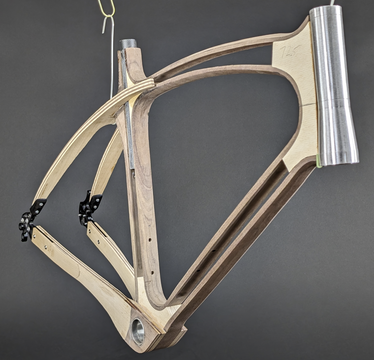 by Christo on 10/10/2024
by Christo on 10/10/2024
When haven't bikes been built with tubes? Manufactured tubes in all metals, all diameters and all wall thickness are available off the shelf. So is carbon fiber in tubes. It makes it an obvious choice to pull them off the shelf, connect them to lugs, and presto, a bike frame. This blog asked the question of whether it's a good idea to use tubes. The short answer is "not so much". The problem with tubes is that they have uniform wall thickness throughout, and usually a uniform diameter. A bike frame can have different wall thickness in different parts of the tubes to take advantage of weight savings and performance characteristics. Should a side wall be the same thickness as the top and bottom wall? Should one end of a tube be the same diameter as the other end of the tube. The answer to both is "no". A bike frames wants to give you some vertical dampening for comfort, and lateral stiffness for performance. Give that bike frame the same wall thickness on the tube, and it can't deliver those for the rider. The tube thickness has to be the thickest required for any location on that tube, and it has to be that thickness everywhere. It has to be round everywhere. It is going to be thicker, and heavier than needed in most locations on that tube. Sophisticated tube shaping is possible but expensive. It is not used often, but taken to the limit of what can be accomplished mechanically, it can produce a revolutionary frame. However, we don't see them from independent builders or at prices that aren't sky high. .
As an independent builder working in wood, I can easily adjust wall thickness, taper and shape of the hollow wood tubes. I even add different woods in different places on the tubes to accomplish different tasks. The top and bottom of the tubes are designed to offer dampening and vertical compliance in the ride. The sides of the tubes are stiff to allow for great performance and feel. Different species of wood even allow for different frequencies of vibrations to be attenuated. If one wood doesn't get a vibration, the other wood can. The image above shows the tops and bottoms of the tubes made from Walnut. I often use walnut in this position for it's dampening properties. The side decking will be maple, something I turn to for stiffness often in the sides of the tubes. All those parts are hollowed out before they are bonded together to make the hollow, tapered tube. Wall thickness varies depending on what I am asking it to do in the frame. So much tuning and customization is possible in a frame built this way that it is as much a work of art in the inside engineering as it is visually on the outside of the frame.
